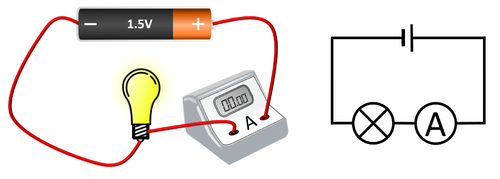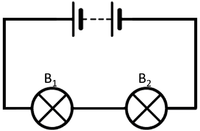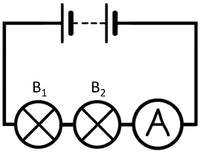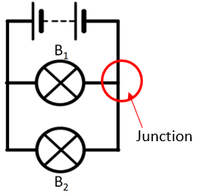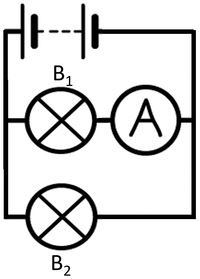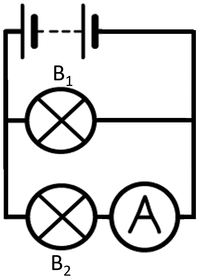Difference between revisions of "Ammeter"
(→About Ammeters) |
|||
| Line 23: | Line 23: | ||
: An ideal [[ammeter]] has zero [[Electrical Resistance|resistance]] because otherwise adding an [[ammeter]] to a [[circuit]] would change the [[Electrical Current|current]]. | : An ideal [[ammeter]] has zero [[Electrical Resistance|resistance]] because otherwise adding an [[ammeter]] to a [[circuit]] would change the [[Electrical Current|current]]. | ||
: [[Ammeter]]s can be [[Analogue Ammeter|analogue]] with a needle pointing to numbers on a dial or it can be [[Digital Ammeter|digital]] with a number display. | : [[Ammeter]]s can be [[Analogue Ammeter|analogue]] with a needle pointing to numbers on a dial or it can be [[Digital Ammeter|digital]] with a number display. | ||
| + | |||
{| class="wikitable" | {| class="wikitable" | ||
|- | |- | ||
| − | |[[File: | + | |[[File:CircuitDiagramBatteryBulbBulbSeries.png|center|200px]] |
| + | |[[File:CircuitDiagramBatteryBulbBulbSeries.png|center|200px]] | ||
|- | |- | ||
| − | | style="height:20px; width:200px; text-align:center;" | | + | | style="height:20px; width:200px; text-align:center;" |To [[measure]] the [[Electrical Current|current]] through bulb 1 the [[ammeter]] can be placed anywhere in this [[Series Circuit|series circuit]]. |
| + | | style="height:20px; width:200px; text-align:center;" |To [[measure]] the [[Electrical Current|current]] through bulb 2 the [[ammeter]] can be placed anywhere in this [[Series Circuit|series circuit]]. | ||
| + | |- | ||
| + | |[[File:CircuitDiagramBatteryBulbBulbAmmeterSeries.png|center|200px]] | ||
| + | |[[File:CircuitDiagramBatteryBulbBulbAmmeterSeries.png|center|200px]] | ||
| + | |} | ||
| + | |||
| + | {| class="wikitable" | ||
| + | |- | ||
| + | |[[File:CircuitDiagramBatteryBulbBulbParallel.png|center|200px]] | ||
| + | |[[File:CircuitDiagramBatteryBulbBulbParallel.png|center|200px]] | ||
| + | |- | ||
| + | | style="height:20px; width:200px; text-align:center;" |To [[measure]] the [[Electrical Current|current]] through bulb 1 the [[ammeter]] must be placed in [[Series Circuit|series]] with bulb 1. | ||
| + | | style="height:20px; width:200px; text-align:center;" |To [[measure]] the [[Electrical Current|current]] through bulb 2 the [[ammeter]] must be placed in [[Series Circuit|series]] with bulb 2. | ||
| + | |- | ||
| + | |[[File:CircuitDiagramBatteryBulbAmmeterBulbParallel.png|center|200px]] | ||
| + | |[[File:CircuitDiagramBatteryBulbBulbAmmeterParallel.png|center|200px]] | ||
|} | |} | ||
Revision as of 13:02, 25 February 2019
Key Stage 3
Meaning
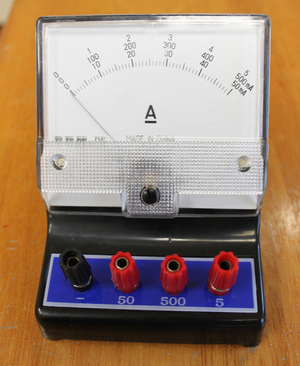
A picture showing an analogue ammeter.
An ammeter is a measuring device used to measure electrical current.
About Ammeters
- Ammeters are added in series to a circuit to find the current flowing through the circuit.
- An ideal ammeter has zero resistance because otherwise adding an ammeter to a circuit would change the current.
- Ammeters can be analogue with a needle pointing to numbers on a dial or it can be digital with a number display.
| An ammeter placed in series with a bulb. |
Key Stage 4
Meaning
An ammeter is a measuring device used to measure electrical current.
About Ammeters
- Ammeters are added in series to a circuit to find the current flowing through the circuit.
- An ideal ammeter has zero resistance because otherwise adding an ammeter to a circuit would change the current.
- Ammeters can be analogue with a needle pointing to numbers on a dial or it can be digital with a number display.
| To measure the current through bulb 1 the ammeter can be placed anywhere in this series circuit. | To measure the current through bulb 2 the ammeter can be placed anywhere in this series circuit. |
| To measure the current through bulb 1 the ammeter must be placed in series with bulb 1. | To measure the current through bulb 2 the ammeter must be placed in series with bulb 2. |
